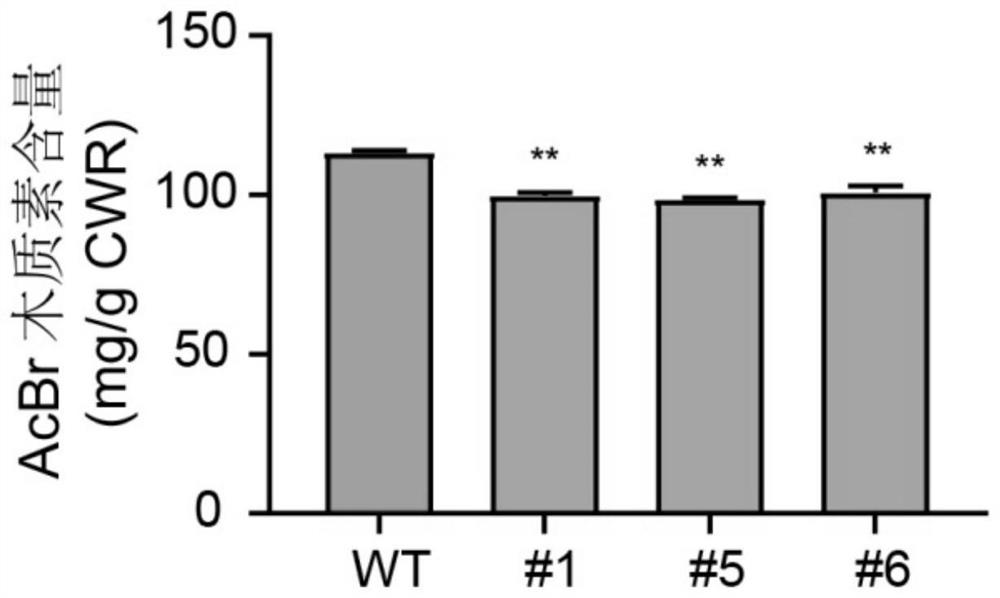miR408 and application of biological material related to miR408
A biological material and plant technology, applied in the field of plant genetic engineering and biology, can solve problems affecting normal growth, achieve the effects of increasing utilization efficiency, delaying lignification of stems, and reducing lignin content of stems
- Summary
- Abstract
- Description
- Claims
- Application Information
AI Technical Summary
Problems solved by technology
Method used
Image
Examples
Embodiment 1
[0069] The construction of embodiment 1 plant expression vector pCAMBIA-2300-35S-pagmiR408 vector
[0070] 1. Obtaining the target gene: using the cDNA of wild-type 84K poplar as a template, using pagmiR408-F and pagmiR408-R as primers (introducing KpnⅠ and BamHI recognition sites and Protected bases), amplified by RT-PCR, the size of the obtained PCR products was identified by agarose gel electrophoresis, and then gel recovery was performed, and the recovered products were sequenced to obtain the recognition sites and protected bases containing KpnⅠ and BamHI The recovered product of the gene encoding the precursor of miR408 (or the gene encoding miR408) shown in SEQ ID NO.2 (abbreviated as pagmiR408). The nucleotide sequence of miR408 is shown in SEQ ID NO.1. The nucleotide sequence of the precursor of miR408 is shown in SEQ ID NO.3.
[0071] The primer sequences are as follows:
[0072] pagmiR408-F: 5'-GG GGTACC AGAGACAGATGAAGACGGGG-3' (the underline is the recognition...
Embodiment 2
[0076] Obtaining and qRT-PCR analysis of embodiment 2 transgenic plants
[0077] 1. Obtaining of transgenic plants
[0078] Agrobacterium-mediated leaf disc method (this method is described in the non-patent literature "Gang Z, Kang ZS, Sun YF, Han QM, Xiao-Fei LU (2005) Establishment of gene transformation receptor system for poplar 84K. Journal of Northwest Sci -Tech University of Agriculture and Forestry 33:87-90), the pCAMBIA-2300-35S-pagmiR408 constructed in Example 1 was transformed into 84K poplar to obtain transgenic plants.
[0079] The genomic DNA of leaves of transgenic plants was extracted respectively, and the genomic DNA of leaves of transgenic plants was used as a template, the genomic DNA of wild-type 84K poplar leaves was used as a negative control, and pCAMBIA-2300-35S-pagmiR408 was used as a positive control. The 5' end of the 35S promoter of -35S-pagmiR408 designs upstream primer (35S-F: 5'-CCACGTCTTCAAAGCAAGT-3') and uses the recognition site of the enzym...
Embodiment 3
[0085] Example 3 Analysis of growth phenotypes of overexpressed transgenic plants and wild-type plants
[0086] 1. Plant growth analysis: the plant height, base diameter, number of internodes, internode 5 (IN5) and internode 15 of wild-type 84K poplar and overexpression miR408 transgenic lines 1, 5 and 6 grown in the greenhouse for 6 months The internode length and internode width of the internode (IN15) were measured, and 10 strains were measured for each strain, and the results were averaged.
[0087] The measurement results of plant height and base diameter were analyzed, and the results of plant height were as follows figure 2 As shown in middle a and c: the growth status and plant height of the overexpressed miR408 transgenic lines 1, 5 and 6 (indicated by "#1", "#5" and "#6" respectively in the figure) were significantly higher than those of the wild Type 84K poplar (indicated by "WT" in the figure); the results of the base diameter are as follows figure 2 Shown in m...
PUM
 Login to View More
Login to View More Abstract
Description
Claims
Application Information
 Login to View More
Login to View More - R&D
- Intellectual Property
- Life Sciences
- Materials
- Tech Scout
- Unparalleled Data Quality
- Higher Quality Content
- 60% Fewer Hallucinations
Browse by: Latest US Patents, China's latest patents, Technical Efficacy Thesaurus, Application Domain, Technology Topic, Popular Technical Reports.
© 2025 PatSnap. All rights reserved.Legal|Privacy policy|Modern Slavery Act Transparency Statement|Sitemap|About US| Contact US: help@patsnap.com



